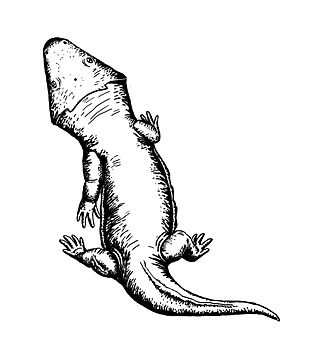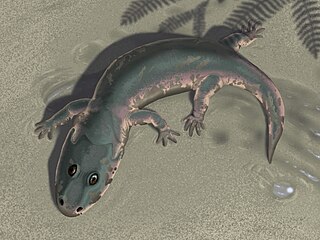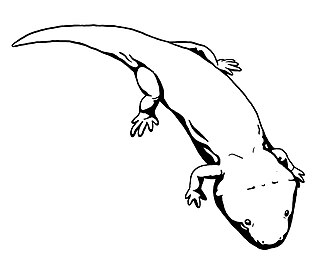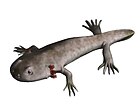
Lystrosaurus is an extinct genus of herbivorous dicynodont therapsids from the late Permian and Early Triassic epochs. It lived in what is now Antarctica, India, China, Mongolia, European Russia and South Africa. Four to six species are currently recognized, although from the 1930s to 1970s the number of species was thought to be much higher. They ranged in size from that of a small dog to 8 feet long.
Deltasaurus kimberleyensis was a temnospondyl amphibian of the family Rhytidosteidae that existed during the Carnian stage of the Triassic. The fossilised remains were discovered in the Blina Shale formation in the Kimberley region of northwest Australia in 1965.

Cherninia is an extinct genus of mastodonsaurid temnospondyl. The type species, Cherninia denwai, is known from the Denwa Formation of India. It is based on a massive skull, ISI A 54, which was originally considered a species of Parotosuchus in 1998 before being given its own genus in 2001.

Laidleria is an extinct genus of temnospondyl that likely lived between the Early to Middle Triassic, though its exact stratigraphic range is less certain. Laidleria has been found in the Karoo Basin in South Africa, in Cynognathus Zone A or B. The genus is represented by only one species, L. gracilis, though the family Laidleriidae does include other genera, such as Uruyiella, sister taxon to Laidleria, which was discovered and classified in 2007.

Deltasaurus is an extinct genus of Carnian temnospondyl amphibian of the family Rhytidosteidae.
Rhytidosteoidea is a superfamily of Temnospondyli, early amphibian species that existed during the Carboniferous, Permian, and Triassic periods. The taxon was established in 1965 to accommodate two new species of Deltasaurus, the author recognising an alliance with previously described genera.

Myosaurus is a genus of Anomodontia in the order Therapsida. They are also classified as Dicynodontia, which is a subclade of Anomodontia. The Mysosaurus was a small, herbivorous reptile that existed around the early Triassic period. All of the fossils found of this species were found in Antarctica and South Africa. Compared to other fossils found from species that existed during this time, the Myosaurus is not common in the fossil record. This is due to a shortage of discovered fossils that possess characteristics unique to the Myosaurus. Notably, under 130 fossil fragments have been found that have been classified as Myosauridae, and almost all have been skulls. These skulls can be classified as Myosaurus because this species, unlike other dicynodonts, do not possess tusks or postfrontal teeth. The only species identified in the family Myosauridae is the Myosaurus Gracilis, or M. Gracilis. It should be recognized that the Myosaurus is almost always referred to as the M. Gracilis in scientific research.
Deltasaurus pustulatus is an amphibian fossil species of the family Rhytidosteidae. The temnospondyl hunted invertebrates and fish during the late stage Triassic epoch, and somewhat resembles the only other species of the eastern Gondwanan genus Deltasaurus. The only known evidence of the species was discovered in a drill core in Southwest Australia, near Geraldton, a seemingly improbable event that produced the only known example of Triassic vertebrate fauna in the ecologically exceptional region's Kockatea Formation.

Cryobatrachus is an extinct genus of temnospondyl amphibian from the Early Triassic of Antarctica. The type species is Cryobatrachus kitchingi. It is known from a partial skull and an imprint of the skull roof, both found in the Fremouw Formation of the Transantarctic Mountains at about 85° south latitude and described in 1974. Many small bone fragments have also been identified, although they cannot be attributed with certainty to C. kitchingi. Cryobatrachus has been classified in the family Lydekkerinidae, as it is similar in appearance to the genus Lydekkerina from South Africa. Because only a small number of features distinguish it from other lydekkerinids, Cryobatrachus kitchingi has more recently been considered a nomen dubium, meaning that its distinction from other better-known species may be unwarranted.
Chomatobatrachus is a genus of prehistoric temnospondyl from the Triassic.

Derwentia is an extinct genus of trematosaurian temnospondyl within the family Rhytidosteidae. It is known from a single skull found from the Knocklofty Sandstone of Tasmania, which is Early Triassic in age.

Indobrachyops is an extinct genus of temnospondyl amphibian from the Early Triassic of India. It is known from a nearly complete fossil skull that was first described by paleontologists Friedrich von Huene and M. R. Sahni in 1958 from the Panchet Formation in Raniganj Coalfield. Indobrachyops belongs to a group of mostly semi-aquatic temnospondyls called Stereospondyli, but its exact placement within the group has been uncertain since its first description.
Notobrachyops is a genus of brachyopid temnospondyl amphibian. It is known from a skull roof impression found in the Ashfield Shale of Mortdale, New South Wales, Australia. The Ashfield Shale has also yielded a shark species, a lungfish species, six species of paleoniscid fish, a species of holostean fish, a subholostean fish, and the labyrinthodont amphibian Paracyclotosaurus davidi.

Lydekkerina is an extinct genus of stereospondyl temnospondyl. It is the type genus of the family Lydekkerinidae. Fossils have been collected from Early Triassic deposits in South Africa and Australia. The type species is L. huxleyi, first described in 1889. While most other stereospondyls were semiaquatic, Lydekkerina was exclusively terrestrial.
Rotaurisaurus is an extinct genus of amphibian-grade tetrapod from the family Lapillopsidae. This genus is known only from an incomplete crushed skull and associated left jaw, together given the designation UTGD 87795. The generic name, Rotaurisaurus, is a combination of Latin words translating to "circle-eared lizard". This references the shape of its otic notches, which acquire a circular form due to being partially enclosed by the tabular bones at the back of the skull. The specific name, contundo, references the specimen's poor level of preservation, as it is derived from the Latin word for "squashed".

Heptasuchus is an extinct genus of loricatan pseudosuchian known from the Middle or Late Triassic upper Chugwater Group of Wyoming, United States. It contains a single species, Heptasuchus clarki, the first formally recognized "rauisuchian" or loricatan pseudosuchian from North America.

Trucheosaurus is an extinct genus of rhytidosteid temnospondyl from the Late Permian period of the Sydney Basin, New South Wales, Australia. It is known from the holotype materials MMF 12697a, a partially complete skull, AMF 50977, an articulated postcranial skeleton and BMNHR 3728, the counterpart of both skull and postcranial skeleton, recovered from the Glen Davis Formation. This genus was named by Watson in 1956, and the type species is Trucheosaurus major.

Eolydekkerina is an extinct genus of temnospondyl amphibian from the Early Triassic of South Africa. It belongs to the family Lydekkerinidae, along with the closely related genus Lydekkerina. It is known from a single type species, Eolydekkerina magna, which was named in 1996 from a part of the Beaufort Group called the Lystrosaurus Assemblage Zone.

Manubrantlia was a genus of lapillopsid from the Early Triassic Panchet Formation of India. This genus is only known from a single holotype left jaw, given the designation ISI A 57. Despite the paucity of remains, the jaw is still identifiable as belonging to a relative of Lapillopsis. For example, all three of its coronoid bones possessed teeth, the articular bone is partially visible in lateral (outer) view, and its postsplenial does not contact the posterior meckelian foramen. However, the jaw also possesses certain unique features which justify the erection of a new genus separate from Lapillopsis. For example, the mandible is twice the size of any jaws referred to other lapillopsids. The most notable unique feature is an enlarged "pump-handle" shaped arcadian process at the back of the jaw. This structure is responsible for the generic name of this genus, as "Manubrantlia" translates from Latin to the English expression "pump-handle". The type and only known species of this genus is Manubrantlia khaki. The specific name refers to the greenish-brown mudstones of the Panchet Formation, with a color that had been described as "khaki" by the first British geologists who studied the formation.
Latiscopus disjunctus is a small Late Triassic temnospondyl collected in 1940 by a Works Projects Administration crew working near Otis Chalk, Texas that was described by John Wilson in 1948.


























